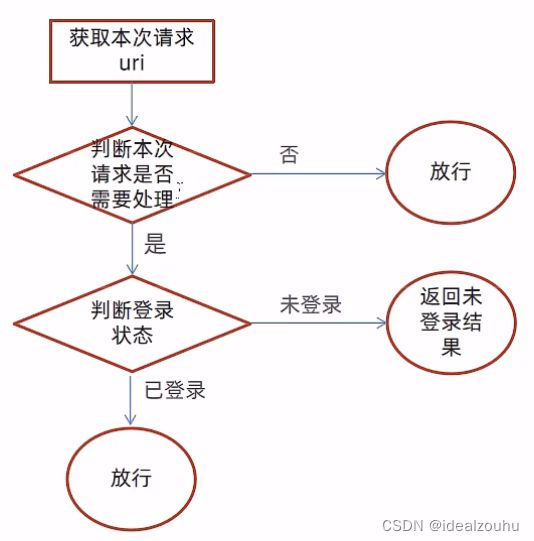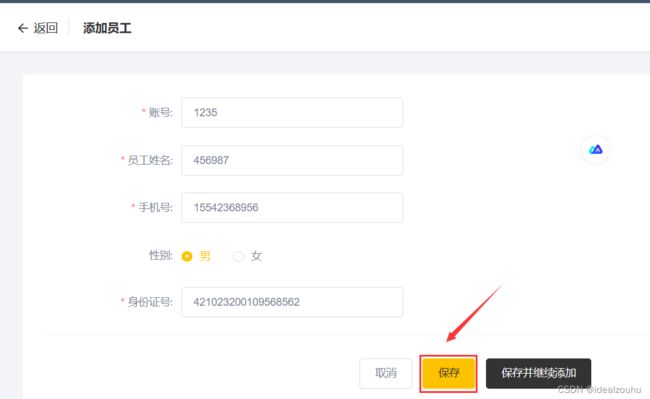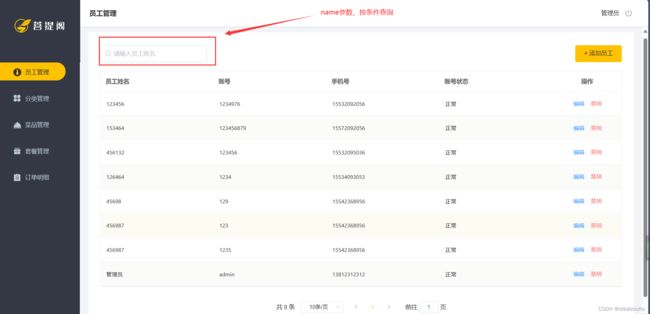瑞吉外卖笔记系列(2) —— 完善员工的后台系统登录功能,实现员工信息管理
本文档主要 完善员工的后台系统登录功能,新增员工,员工信息分页查询,启用/禁用员工账号,编辑员工信息
一、完善后台系统登录功能
1.1 问题分析
目前存在的问题是:理论上,用户必须在 http://localhost:8080/backend/page/login/login.html 登录,才能访问系统首页。但是,现在用户如果不登录,依然可以访问系统的首页 http://localhost:8080/backend/index.html
1.2 解决方案
针对该问题,解决方案主要有:使用过滤器或者拦截器,在过滤器或者拦截器中判断用户是否已经完成登录,如果没有则跳转到登录页面。
本项目选择过滤器这一解决方案 , 实现步骤为:
- 创建自定义过滤器 LoginCheckfilter
- 在启动类上加入注解 @ServletComponentScan
- 完善过滤器实现逻辑
过滤器具体的处理逻辑如下:
1.3 前端代码分析
在 src/main/resources/backend/js/request.js 文件,前端响应拦截器的代码如下:
// 响应拦截器
service.interceptors.response.use(res => {
if (res.data.code === 0 && res.data.msg === 'NOTLOGIN') {// 返回登录页面
console.log('---/backend/page/login/login.html---')
localStorage.removeItem('userInfo')
window.top.location.href = '/backend/page/login/login.html'
} else {
return res.data
}
}
NOTLOGIN 字符串将会用于 后端的拦截器的实现。
1.4 代码实现
新建 java 类 src/main/java/com/idealzouhu/reggie/filter/LoginCheckFilter.java, 具体代码如下:
/**
* 检查用户是否已经完成了登录
*/
@Slf4j
@WebFilter(filterName = "loginCheckFilter", urlPatterns = "/*")
public class LoginCheckFilter implements Filter {
// 路径匹配器,支持通配符
public static final AntPathMatcher PATH_MATCHER = new AntPathMatcher();
/**
* 路径匹配,检测本次请求是否需要放行
* @param urls
* @param requestURI
* @return
*/
public boolean check(String[] urls, String requestURI){
for( String url : urls){
boolean match = PATH_MATCHER.match(url, requestURI);
if(match){
return true;
}
}
return false;
}
@Override
public void doFilter(ServletRequest servletRequest, ServletResponse servletResponse, FilterChain filterChain) throws IOException, ServletException {
HttpServletRequest request = (HttpServletRequest) servletRequest;
HttpServletResponse response = (HttpServletResponse) servletResponse;
// 1. 获取本次请求的URI
String requestURI = request.getRequestURI();
log.info("拦截到请求: {}",request.getRequestURI());
// 2. 判断本次请求是否需要处理
String[] urls = new String[]{ // 定义不需要处理的请求路径;
"/employee/login",
"/emplyee/logout",
"/backend/**",
"/front/**"
};
boolean check = check(urls, requestURI);
// 3. 如果不需要处理,则直接放行
if(check){
log.info("本次请求 {} 不需要处理",request.getRequestURI());
filterChain.doFilter(request, response);
return;
}
// 4. 判断登录状态,如果已登录,则直接放行
if(request.getSession().getAttribute("employee") != null){
log.info("用户已登录,id为: {} ",request.getSession().getAttribute("employee"));
filterChain.doFilter(request, response);
return;
}
// 5. 如果未登录则返回未登录结果. 通过输出流方式向客户端页面响应数据
log.info("用户未登录");
response.getWriter().write(JSON.toJSONString(R.error("NOTLOGIN")));
return;
}
}
注意,官方视频在这里少打了一个 return ,导致登录用户存放在session里面会被删掉(即误执行response.getWriter().write(JSON.toJSONString(R.error("NOTLOGIN"))) ,间接执行前端代码localStorage.removeItem('userInfo') )。
1.5 功能测试
直接访问 http://localhost:8080/backend/index.html , 看页面是否会跳转到登录页面
二、新增员工
2.1 需求分析
在后台管理系统中, 通过新增员工来添加后台系统用户。
2.2 数据模型
需要注意,employee 表中对 username 字段加入了唯一约束。因为 username 是员工的登录账号,具备唯一性。

2.3 前端代码分析
员工列表页面为 src/main/resources/backend/page/member/list.html,
<el-button
type="primary"
@click="addMemberHandle('add')"
>
+ 添加员工
el-button>
..........
// 添加
addMemberHandle (st) {
if (st === 'add'){
window.parent.menuHandle({
id: '2',
url: '/backend/page/member/add.html',
name: '添加员工'
},true)
} else {
window.parent.menuHandle({
id: '2',
url: '/backend/page/member/add.html?id='+st,
name: '修改员工'
},true)
}
}
menuHandle方法的实现在 src/main/resources/backend/index.html 里面,
mounted() {
window.menuHandle = this.menuHandle
},
menuHandle(item, goBackFlag) {
this.loading = true
this.menuActived = item.id
this.iframeUrl = item.url
this.headTitle = item.name
this.goBackFlag = goBackFlag
this.closeLoading()
}
最后,在添加员工的页面 src/main/resources/backend/page/member/add.html,点击保存按钮, 会触发 addEmployee() 方法
submitForm (formName, st) {
this.$refs[formName].validate((valid) => {
if (valid) {
if (this.actionType === 'add') {
const params = {
...this.ruleForm,
sex: this.ruleForm.sex === '女' ? '0' : '1'
}
addEmployee(params).then(res => {
if (res.code === 1) {
this.$message.success('员工添加成功!')
if (!st) {
this.goBack()
} else {
this.ruleForm = {
username: '',
'name': '',
'phone': '',
// 'password': '',
// 'rePassword': '',/
'sex': '男',
'idNumber': ''
}
}
addEmployee() 方法的实现代码在 backend/api/member.js 里面
// 新增---添加员工
function addEmployee (params) {
return $axios({
url: '/employee',
method: 'post',
data: { ...params }
})
}
需要注意,我将 url 改成 ‘/employee/addEmployee’
前端代码较为复杂,建议观看原视频业务开发Day2-06-新增员工_梳理程序执行流程_哔哩哔哩_bilibili
2.4 代码开发
在开发代码之前,需要梳理一下整个程序的执行过程:
- 页面发送ajax请求,将新增员工页面中输入的数据以json的形式提交到服务端
- 服务端Contraller接收页面提交的数据并调用Service将数据进行保存
- Service调用Mapper操作数据库,保存数据

在 employee 里面新建方法 ,
/**
* 新增员工
* @param employee
* @return
*/
@PostMapping("/addemployee")
public R addEmployee(HttpServletRequest request,@RequestBody Employee employee){
log.info("新增员工, 员工信息:{}", employee.toString());
// 设置初始密码 123456, 需要进行MD5 加密处理
employee.setPassword(DigestUtils.md5DigestAsHex("123456".getBytes()));
employee.setCreateTime(LocalDateTime.now());
employee.setUpdateTime(LocalDateTime.now());
// 获得当前登录用户的id
Long empID = (Long) request.getSession().getAttribute("employee");
employee.setCreateUser(empID);
employee.setUpdateUser(empID);
employeeService.save(employee);
return R.success("新增员工成功");
// return null; // 如果返回 null 值,会导致前端页面莫名其妙跳转到 登录页面,并删除登录信息
}
2.5 功能测试
输入员工信息,点击 “保存”
在数据库里面,也可以看到相应的信息
另外,如果我们再次新增用户名为 1235 的用户,后台会报错
java.sql.SQLIntegrityConstraintViolationException: Duplicate entry '1235' for key 'employee.idx_username'
这是因为 username 是员工的登录账号,具备唯一性。
2.6 代码修复
前面的程序还存在一个问题:当新增员工的账号已经存在时,由于 username 具备唯一性,程序会抛出异常
java.sql.SQLIntegrityConstraintViolationException: Duplicate entry '1235' for key 'employee.idx_username'
此时需要我们进行异常捕获,通常有两种处理方式:
- 在Controller 方法中加入 try、catch 进行异常捕获
- 使用异常处理器进行全局异常捕获 (本文采用这种方式)
创建 src/main/java/com/idealzouhu/reggie/common/GlobalExceptionHandler.java, 实现代码为:
package com.idealzouhu.reggie.common;
import lombok.extern.slf4j.Slf4j;
import org.springframework.stereotype.Controller;
import org.springframework.web.bind.annotation.ControllerAdvice;
import org.springframework.web.bind.annotation.ExceptionHandler;
import org.springframework.web.bind.annotation.ResponseBody;
import org.springframework.web.bind.annotation.RestController;
import java.sql.SQLIntegrityConstraintViolationException;
/**
* 全局异常处理
*/
@Slf4j
@ControllerAdvice(annotations = {RestController.class, Controller.class})
@ResponseBody
public class GlobalExceptionHandler {
/**
* 处理新增员工账号已经存在时抛出的异常
* @return
*/
@ExceptionHandler(SQLIntegrityConstraintViolationException.class)
public R exceptionHandler(SQLIntegrityConstraintViolationException ex){
log.error(ex.getMessage());
if(ex.getMessage().contains("Duplicate entry")){
String[] split = ex.getMessage().split(" ");
String msg = split[2] + "已存在";
return R.error(msg);
}
return R.error("未知错误");
}
}
2.7 总结
- 根据产品原型明确业务需求
- 重点分析数据的流转过程和数据格式
- 通过debug断点调试跟踪程序执行过程
三、员工信息分页查询
3.1 需求分析
当员工数量较多时,我们需要分页查询员工信息,便于查看。
同时,我们还可以根据员工姓名查询,即按条件分页查询。
其中,参数主要有 page、pagesize,name。name是我们按条件分页查询的条件
3.2 前端代码分析
(1) List.html
员工列表页面为 src/main/resources/backend/page/member/list.html,
这部分代码展示了 为什么员工信息查询会每次自动请求。
:page-sizes="[10, 20, 30, 40]" : 对应 分页查询里面的下拉条, 即每页显示多少页。
pageSize: 10: 表示默认值,即每页显示 10 页
(2)getMemberList()
getMemberList() 方法的实现代码在 backend/api/member.js 里面
function getMemberList (params) {
return $axios({
url: '/employee/page',
method: 'get',
params
})
}
(3) request.js
我们会发现一个问题:在list.html, page 和pagesize 参数是 json 格式。但是,在URI里面,参数并不是 json 格式,而是 http://localhost:8080/employee/page?page=1&pageSize=10。
在 src/main/resources/backend/js/request.js , request拦截器将参数重新组装,放在 URI 的后面
// request拦截器
service.interceptors.request.use(config => {
// get请求映射params参数
if (config.method === 'get' && config.params) {
let url = config.url + '?';
for (const propName of Object.keys(config.params)) {
const value = config.params[propName];
var part = encodeURIComponent(propName) + "=";
if (value !== null && typeof(value) !== "undefined") {
if (typeof value === 'object') {
for (const key of Object.keys(value)) {
let params = propName + '[' + key + ']';
var subPart = encodeURIComponent(params) + "=";
url += subPart + encodeURIComponent(value[key]) + "&";
}
} else {
url += part + encodeURIComponent(value) + "&";
}
}
}
3.3 代码开发
在开发代码之前,需要梳理一下整个程序的执行过程:
- 页面发送ajax请求,将分页查询参数(page、pageSize、name)提交到服务端
- 服务端Controller接收页面提交的数据并调用Service查询数据
- Service调用Mapper操作数据库,查询分页数据
- Controller将查询到的分页数据响应给页面
- 页面接收到分页数据并通过ElementUI的Table组件展示到页面上
为了更好地实现分页查询,我们使用MP提供的分页查询:
(1)配置 MP 分页插件
创建src/main/java/com/idealzouhu/reggie/config/MybatisPlusConfig.java
package com.idealzouhu.reggie.config;
import com.baomidou.mybatisplus.extension.plugins.MybatisPlusInterceptor;
import com.baomidou.mybatisplus.extension.plugins.inner.PaginationInnerInterceptor;
import org.springframework.context.annotation.Bean;
import org.springframework.context.annotation.Configuration;
/**
* 配置 MP 的分页插件
*/
@Configuration
public class MybatisPlusConfig {
@Bean
public MybatisPlusInterceptor mybatisPlusInterceptor(){
MybatisPlusInterceptor mybatisPlusInterceptor = new MybatisPlusInterceptor();
mybatisPlusInterceptor.addInnerInterceptor(new PaginationInnerInterceptor());
return mybatisPlusInterceptor;
}
}
(2)创建 controller 方法
在src/main/java/com/idealzouhu/reggie/controller/EmployeeController.java类里面,新建方法
@GetMapping("/page")
public R page(int page, int pageSize, String name){
log.info("page = {}, pageSize = {}, name={} ", page, pageSize,name);
// 1. 构造分页查询器
Page pageInfo = new Page(page, pageSize);
// 2. 构造条件构造器
LambdaQueryWrapper lambdaQueryWrapper = new LambdaQueryWrapper();
lambdaQueryWrapper.like(StringUtils.isNotEmpty(name), Employee::getName, name); // 添加过滤条件
lambdaQueryWrapper.orderByDesc(Employee::getUpdateTime); // 添加排序条件
// 3.执行查询
employeeService.page(pageInfo, lambdaQueryWrapper);
return R.success(pageInfo);
}
3.4 功能测试
直接查看员工信息分页是否正常
四、启用/禁用员工账号
4.1 需求分析
在员工管理列表页面,可以对某个员工账号进行启用或者禁用操作。账号禁用的员工不能登录系统,启用后的员工可以正常登录。
需要注意的是,只有管理员 admin 具备权限,可以对所用员工账号进行启用、禁用操作。所以普通用户登录系统后启用、禁用按钮不显示。
如果某个员工账号状态为正常,则按钮显示为 禁用;如果员工账号状态为已禁用, 则按钮显示为 ”启用“。
4.2 前端代码分析
(1) List.html
在员工列表页面 src/main/resources/backend/page/member/list.html,
<el-button
type="text"
size="small"
class="delBut non"
@click="statusHandle(scope.row)"
v-if="user === 'admin'"
>
{{ scope.row.status == '1' ? '禁用' : '启用' }}
</el-button>
..........
created() {
this.init()
// 获取当前登录员工的账号,并赋值给模型数据
this.user = JSON.parse(localStorage.getItem('userInfo')).username
}
.................
//状态修改
statusHandle (row) {
this.id = row.id
this.status = row.status
this.$confirm('确认调整该账号的状态?', '提示', {
'confirmButtonText': '确定',
'cancelButtonText': '取消',
'type': 'warning'
}).then(() => {
enableOrDisableEmployee({ 'id': this.id, 'status': !this.status ? 1 : 0 }).then(res => {
console.log('enableOrDisableEmployee',res)
if (String(res.code) === '1') {
this.$message.success('账号状态更改成功!')
this.handleQuery()
}
}).catch(err => {
this.$message.error('请求出错了:' + err)
})
})
}
{{ scope.row.status == '1' ? '禁用' : '启用' }}: 如果员工账号状态scope.row.status为正常(即1),则按钮显示为 禁用;如果员工账号状态为已禁用, 则按钮显示为 启用
v-if="user === 'admin'": 如果登录用户是管理员,则看到 禁用 、启用按钮。否则的话,则不显示。
statusHandle(): 修改员工状态的 核心函数
(2)enableOrDisableEmployee()
enableOrDisableEmployee() 方法的实现代码在 backend/api/member.js 里面
// 修改---启用禁用接口
function enableOrDisableEmployee (params) {
return $axios({
url: '/employee',
method: 'put',
data: { ...params }
})
}
4.2 代码开发
在开发代码之前,需要梳理一下整个程序的执行过程:
- 页面发送ajax请求,将参数(id、status)提交到服务端
- 服务端Controller接收页面提交的数据并调用Service更新数据
- Service调用Mapper操作数据库
本质上,这段代码的作用是更改员工的 status 字段。
4.3 代码修复
问题:”禁用/启用“功能可以运行,但是数据库里面 status 状态并没有更新
**原因:**前端返回过来的json数据里面,员工 id 和其实际 id 不一样。 js 对 long 型数据进行处理时丢失精度,导致提交的 id 和 数据库中的id 不一致。
**解决方案:**在服务端给页面响应 json 数据时进行处理,将 long 型数据统一转为 String 字符串
具体实现步骤:
- 提供 对象转换器 JacksonObject , 基于 JackSon 进行 Java 对象到json数据的转换。 创建
src/main/java/com/idealzouhu/reggie/common/JacksonObjectMapper.java, 相应代码如下
/**
* 对象映射器:基于jackson将Java对象转为json,或者将json转为Java对象
* 将JSON解析为Java对象的过程称为 [从JSON反序列化Java对象]
* 从Java对象生成JSON的过程称为 [序列化Java对象到JSON]
*/
public class JacksonObjectMapper extends ObjectMapper {
public static final String DEFAULT_DATE_FORMAT = "yyyy-MM-dd";
public static final String DEFAULT_DATE_TIME_FORMAT = "yyyy-MM-dd HH:mm:ss";
public static final String DEFAULT_TIME_FORMAT = "HH:mm:ss";
public JacksonObjectMapper() {
super();
//收到未知属性时不报异常
this.configure(FAIL_ON_UNKNOWN_PROPERTIES, false);
//反序列化时,属性不存在的兼容处理
this.getDeserializationConfig().withoutFeatures(DeserializationFeature.FAIL_ON_UNKNOWN_PROPERTIES);
SimpleModule simpleModule = new SimpleModule()
.addDeserializer(LocalDateTime.class, new LocalDateTimeDeserializer(DateTimeFormatter.ofPattern(DEFAULT_DATE_TIME_FORMAT)))
.addDeserializer(LocalDate.class, new LocalDateDeserializer(DateTimeFormatter.ofPattern(DEFAULT_DATE_FORMAT)))
.addDeserializer(LocalTime.class, new LocalTimeDeserializer(DateTimeFormatter.ofPattern(DEFAULT_TIME_FORMAT)))
.addSerializer(BigInteger.class, ToStringSerializer.instance)
.addSerializer(Long.class, ToStringSerializer.instance)
.addSerializer(LocalDateTime.class, new LocalDateTimeSerializer(DateTimeFormatter.ofPattern(DEFAULT_DATE_TIME_FORMAT)))
.addSerializer(LocalDate.class, new LocalDateSerializer(DateTimeFormatter.ofPattern(DEFAULT_DATE_FORMAT)))
.addSerializer(LocalTime.class, new LocalTimeSerializer(DateTimeFormatter.ofPattern(DEFAULT_TIME_FORMAT)));
//注册功能模块 例如,可以添加自定义序列化器和反序列化器
this.registerModule(simpleModule);
}
}
- 在 WebMvcConfig 配置类中扩展 Spring MVC 的消息转换器,在此消息转换器中使用提供对象转换器进行 Java 对象到 json 数据的转换。如果不扩展的话,那么项目会使用 Spring MVC 所使用的默认配置器。
/**
* 扩展 MVC 框架的消息转换器
* @param converters
*/
@Override
public void extendMessageConverters(List<HttpMessageConverter<?>> converters) {
log.info("扩展消息转换器");
// 创建消息转换器对象
MappingJackson2HttpMessageConverter messageConverter = new MappingJackson2HttpMessageConverter();
// 设置对象转换器, 底层使用 Jackson 将对象转为 json
messageConverter.setObjectMapper(new JacksonObjectMapper());
// 将上面的消息转换器对象追加到 MVC 框架的转换器集合中
converters.add(0, messageConverter);
// WebMvcConfigurer.super.extendMessageConverters(converters);
}
我们可以通过调试来观察消息转换器是否添加成功
我们再次运行启用/禁用 功能,可以很明显观察到 json 对象的变化
五、编辑员工账号
5.1 需求分析
在员工管理页面点击编辑按钮在员工管理列表页面点击编辑按钮,跳转到编辑页面,在编辑页面回显员工信息并进行修改,最后点击保存按钮完成编辑操作。
对于编辑员工,如果员工不存在,则是 新增员工。如果员工已存在,则是 编辑员工。因此,对于后端而言,编辑员工和新增员工的代码基本上类似。
5.2 前端代码分析
(1) add.html
注意: add.html 页面为公共页面,新增员工和编辑员工都是在此页面操作
在 src/main/resources/backend/page/member/add.html 里面,
created() {
this.id = requestUrlParam('id')
this.actionType = this.id ? 'edit' : 'add'
if (this.id) {
this.init()
}
}
......
async init () {
queryEmployeeById(this.id).then(res => {
console.log(res)
if (String(res.code) === '1') {
console.log(res.data)
this.ruleForm = res.data
this.ruleForm.sex = res.data.sex === '0' ? '女' : '男'
// this.ruleForm.password = ''
} else {
this.$message.error(res.msg || '操作失败')
}
})
}
this.actionType = this.id ? 'edit' : 'add': id 有值的话,就是编辑员工。否则新增员工
(2)requestUrlParam()
在 src/main/resources/backend/js/index.js 里,requestUrlParam() 解析 url地址上面的参数。举个例子,http://localhost:8080/backend/page/member/add.html?id=1745800121368453122,该函数会将 id 参数动态提取出来。
//获取url地址上面的参数
function requestUrlParam(argname){
var url = location.href
// alert(url)
var arrStr = url.substring(url.indexOf("?")+1).split("&")
for(var i =0;i(3) queryEmployeeById()
在 src/main/resources/backend/api/member.js里, queryEmployeeById() 根据员工 id 查询员工信息
// 修改页面反查详情接口
function queryEmployeeById (id) {
return $axios({
url: `/employee/${id}`,
method: 'get'
})
}
5.2 代码开发
在开发代码之前需要梳理一下操作过程和对应的程序的执行流程:
- 点击编辑按钮时,页面跳转到 add.html,并在 url 中携带参数[员工id] (例如
http://localhost:8080/backend/page/member/add.html?id=1745800121368453122) - 在 add.html 页面获取 url中的参数[员工id]
- 发送 ajax 请求,请求服务端,同时提交员工 id 参数
- 服务端接收请求,根据员工 id 查询员工信息,将员工信息以json形式响应给页面
- 页面接收服务端响应的json数据,通过VUE的数据绑定进行员工信息回显
- 点击保存按钮,发送ajax请求,将页面中的员工信息以json方式提交给服务端
- 服务端接收员工信息,并进行处理,完成后给页面响应
- 页面接收到服务端响应信息后进行相应处理
在 src/main/java/com/idealzouhu/reggie/controller/EmployeeController.java 里面, 添加以下代码:
/**
* 根据id 编辑员工 (事实上,这段代码与下面的功能”启用/禁用员工“一样)
* @param employee
* @return
*/
@PutMapping("/editEmployee")
public R editEmployee(HttpServletRequest request, @RequestBody Employee employee){
log.info(employee.toString());
Long empID = (Long)request.getSession().getAttribute("employee");
employee.setUpdateUser(empID);
employee.setUpdateTime(LocalDateTime.now());
employeeService.updateById(employee);
return R.success("员工信息修改成功");
}
/**
* 根据员工 id 查询信息
* @param id
* @return
*/
@GetMapping("/{id}")
public R getById(@PathVariable Long id){
log.info("根据员工id({})查询信息:", id);
Employee employee = employeeService.getById(id);
if(employee != null){
return R.success(employee);
}
return R.error("没有查询到对应员工信息");
}
参考资料
idealzouhu/reggie-take-out: 瑞吉外卖项目, 利用SpringBoot + SSM技术栈实现 (github.com)
黑马程序员Java项目实战《瑞吉外卖》bilibili










